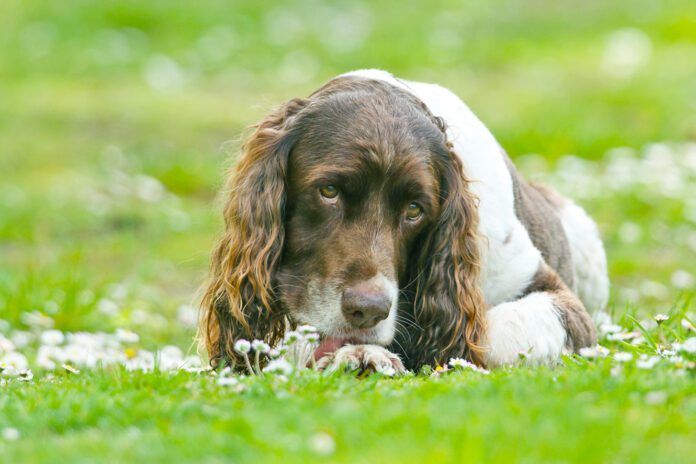Spore-producing yeasts or fungi normally live on canine skin without causing problems, but they can sometimes spread out of control. When a yeast infection on dog paws happens, a dog’s paws will become highly itchy, prompting the dog to lick them. In a very short time they become red and irritated, may develop a cheesy, musty, or pungent odor, and a brown discharge can develop in the nail beds.
The culprit is usually Malassezia pachydermatis, a yeast species that multiplies in warm, moist environments. This overgrowth is most frequently associated with dog allergies, which also cause itching, prompting the dog to lick his feet; the moisture and damage to the skin sparks the yeast overgrowth. A cut, abrasion, or other injury to the paw can also trigger licking and a Malassezia infection.
Dog Paw Yeast Infection Soaks and Other Ineffective Treatments
Frequently suggested home remedies such as vinegar foot soaks, Epsom salt baths, hydrogen peroxide, or witch hazel sprays are ineffective and not supported by clinical research. Other unproven strategies include adding yogurt, probiotics, or coconut oil to your dog’s food, switching to a “yeast-free” or “anti-yeast” dog food, or reducing carbohydrates in your dog’s diet.
Diagnosis of Yeast Infection on Dog Paws
The paws’ appearance and odor makes a yeast infection diagnosis easy, but a veterinarian can confirm this by examining some of the dog’s skin cells under a microscope.
Dogs with skin folds, excessive hair between toes, and underlying health conditions or autoimmune disorders may be susceptible. The breeds most associated with paw pad yeast infections are Bulldogs, Cocker Spaniels, Basset Hounds, Retrievers, Shih Tzus, Poodles, English Setters, West Highland White Terriers, English Springer Spaniels, and Dachshunds.
In general, yeast infections are secondary rather than primary – they develop after another disorder has weakened the dog’s overall health, allowing yeast cells to multiply. If your dog suffers from recurrent infections, your vet will look for signs of an underlying medical condition that is contributing to your dog’s problem. Recurrent Malassezia infections have been associated with conditions such as:
Treating Dog Paw Yeast Infections
Medications that treat canine yeast infections include chlorhexidine, miconazole, ketoconazole, and itraconazole, which should be applied according to your veterinarian’s instructions and may include soaking the affected paws. Be sure to thoroughly dry your dog’s feet after treatment. Keeping your dog’s feet clean and dry and consulting your veterinarian when symptoms appear can keep yeast infections from spreading.
In severe or recurrent cases, oral antifungal medications such as fluconazole or itraconazole work systemically to prevent yeast cells from multiplying.
Preventing Dog Paw Yeast Infections
When it comes to preventing yeast infections, the first step is to identify and treat the underlying cause. Depending on the source of the problem, adjusting your dog’s diet may also help. Feeding higher-quality protein sources and other ingredients can improve the health of his skin, strengthening its defenses against yeast and fungi. Also, if food allergies are suspected, a food elimination trial is in order; talk to your veterinarian about how to conduct an effective food elimination trial.





